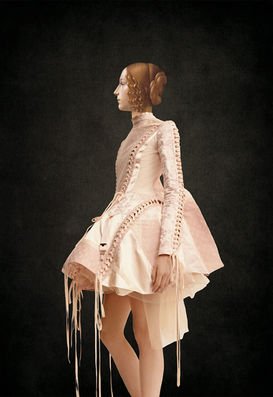THE POWER OF COSTUME
Who Are You Wearing?
As a theatre designer a lot of my work, particularly when it comes to costume design is about the power of clothing. How we choose to dress is key to how we visually communicate with others: our clothes speak of where we come from, which sector of society we identify with, and often indicate our economic situation. How someone is dressed is one of the first things we notice about someone when we meet them either on stage or in real life. And it is something, I think, we make judgements about, whether consciously or subconsciously, on both ourselves and others and how we fit into the wider world. This power of costume is something that lies at the heart of both my costume design work and also these new digital collage artworks created especially for the reopening of the Citizens.
The artworks are inspired by the 6 statues that preside over the Citizens Theatre. I’ve always been a little intrigued by them. To me the visual language of their clothing is a little startling; when I look at them I always ask myself the same question: Why are the male ones of Shakespeare and Burns dressed in their contemporary clothes whilst the female ones of the Four Muses are barely covered by various draping pieces of fabric (albeit skilfully carved in stone)?
I think this is to do with the way in which in Western Art, the dominant creators—painters, writers, composers—were thought to be men, reflecting the patriarchal society in which they lived. From the Renaissance onwards the role of women became much more secondary and any agency or power they had, more often or not, was defined or measured by how they looked. It’s easy to see how this mutated into the traditional perception of a female muse or goddess as more of a passive idealised female object whose purpose was to inspire the true artist, ie. the male.
Obviously I’m not holding Shakespeare or Burns responsible for this. They were, of course, seriously talented guys and as far as I know neither of them needed a scantily clad muse to inspire their artistic endeavours.
But I thought it might be interesting to look at the idea of a muse or goddess afresh. In Ancient Greece the original Nine Muses were indeed goddesses who inspired the creation of the arts, literature, music, and sciences. But they were thought to enable both male and female creativity including their own. This concept is very different from the modern idea of the Muse or Female Goddess as the passive objectified female at the beck and call of the tormented male artist. It makes me think about a lot of the forgotten women creatives from the past. Art history would often have you believe that all the best art has always been made by men and it has only been recently that this concept has begun, rightly, to be redressed.
This revisiting of history and the position of women within it is a central part of my digital collage practice. I do this using the language of clothes. These new works all feature a woman from the past but now reimagined in modern clothing, juxtaposing images created centuries apart to see if this allows us to see the women in a different light. Among the subjects here are three artists, two poets, a politician, a mother, an artists muse and two unknowns. I’d be interested to know if you can tell who is who by how I have dressed them. Answers attached below!
In a way you could think of these a little like a modern dress Shakespeare production; whether you like these or not (‘Not Proper’ as my Grandad used to say, flatly refusing to come see any I designed) But to me what modern dress productions do is make the material and characters more real and relatable. We see ourselves and others in it and them. I hope these works do the same.
Of course the clothing choices I have made for these collages are influenced by my own personal taste and views. They are all (not so coincidentally designed by women). You may or may not agree with them and I would be interested to hear how you would dress them yourselves. I guess that is the point. Creativity and its inspiration is not definitive. It is not confined to one persons view or opinion, or by history, and certainly not by gender. It is for us all. It is in us all.
Thanks:
Dominic Hill, Dr Catrin Evans & Laura Smith at the Citizens Theatre
Rob Kennedy. Calum Stirling, Deadly Digital, GOMA & FramingScotland
Creative Scotland









